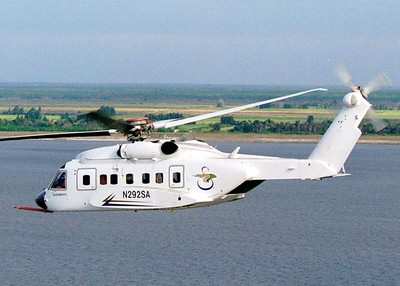Fri, Nov 09, 2012
Sikorsky Gets FAA Approval For The Program
The FAA has approved the grant of life extensions for the Main Rotor Hub on Sikorsky's S-92 helicopter platform to the company. Through its aftermarket business, Sikorsky Aerospace Services (SAS), Sikorsky Aircraft will have the ability to utilize Health and Usage Monitoring System (HUMS) data to determine a one-time life adjustment for particular serial number main rotor hubs in accordance with a methodology accepted by the FAA.

"Beyond monitoring for failure prevention, we have now advanced the usage of HUMS data into the realm of operating cost reductions," said Steve Bohlman, SAS Director, Global Service & Support. "By obtaining FAA approval for our methodology, we have achieved an industry first. Extending the life of a component through individual aircraft usage monitoring is an important first step in using HUMS data to proactively reduce the operating and maintenance cost of the S-92 aircraft."
The S-92 helicopter incorporates numerous safety features, including a flaw tolerant design, and Sikorsky continues to make safety and performance upgrades. HUMS provides another safety enhancement by allowing the SAS Fleet Management Operations Center (FMOC) in Connecticut to monitor, on a continual basis, the health of the worldwide S-92 helicopter fleet. Data collected by the FMOC helps identify maintenance conditions including whether components are wearing as expected.
The life calculation of the S-92A Main Rotor Hub is significantly influenced by rotor blade centrifugal force and the number of Ground-Air-Ground (GAG) cycles. Based on Sikorsky's FAA-approved life calculation methodology, the recommended retirement time for the hub is 4,900 hours. Sikorsky engineering teams have developed a new method for managing the retirement time of the rotor hub. This FAA-approved methodology accounts for actual usage and permits a one-time life extension, while maintaining the same margin of safety.
"The success of this simple HUMS-based retirement procedure serves as a precursor for implementing more sophisticated technologies to manage component retirement times," said Dr. Andreas Bernhard, SAS Director of Analytics & Technology and Chief Engineer. "This paradigm change will result in significant cost savings and reduction of the operator's maintenance burden – as well as impact the design of new products. These types of methodologies can realize optimal weight design and achieve reliability through continuous monitoring of usage, loads, and health."
(File photo Sikorsky S-92)
More News
Also: New Lakeland Fly-in!, Gleim's DPE, MOSAIC! Nearly three-quarters of a century in the making, EAA is excited about the future… especially with the potential of a MOSAIC>[...]
Estimated (EST) -When used in NOTAMs “EST” is a contraction that is used by the issuing authority only when the condition is expected to return to service prior to the >[...]
Aero Linx: Regional Airline Association (RAA) Regional airlines provide critical links connecting communities throughout North America to the national and international air transpo>[...]
The Airplane Broke Up In Flight And Descended To The Ground. The Debris Path Extended For About 1,435 Ft. Analysis: The pilot, who was the owner and builder of the experimental, am>[...]
From 2015 (YouTube version): History Comes Alive Thanks to A Magnificent CAF Effort The story of the Douglas C-47 named, “That’s all Brother,” is fascinating from>[...]
 Airborne 07.21.25: Nighthawk!, Hartzell Expands, Deltahawk 350HP!
Airborne 07.21.25: Nighthawk!, Hartzell Expands, Deltahawk 350HP! ANN's Daily Aero-Term (07.27.25): Estimated (EST)
ANN's Daily Aero-Term (07.27.25): Estimated (EST) ANN's Daily Aero-Linx (07.27.25)
ANN's Daily Aero-Linx (07.27.25) NTSB Final Report: Luce Buttercup
NTSB Final Report: Luce Buttercup Classic Aero-TV: 'That's All Brother'-Restoring a True Piece of Military History
Classic Aero-TV: 'That's All Brother'-Restoring a True Piece of Military History



